Table of Contents
| Title Page | |
| Meetings | |
| The Editor's Notebook | |
| Marine News | |
| Ship of the Month No. 164 Yankcanuck (I) | |
| Islander/Bruce Revisited | |
| Seaway Ocean Vessels | |
| Vessel Passages | |
| Table of Illustrations |
Back when the writer was a youngster, one of the lake steamers which never failed to catch his attention was the veteran craneship YANKCANUCK. Not only was the vessel a rather rare visitor to Toronto, but she also was of a particularly "antique" sort of appearance, and she was the last large composite-hulled freighter operating on the Great Lakes. All of these facts combined to make YANKCANUCK a most unusual ship as far as the young observer was concerned. Unfortunately, however, he only got the chance to see this steamer in the very last few years of her career, for she was out of service and dismantled before the close of the decade of the 1950s.
To many younger lake historians now on the scene, YANKCANUCK will be nothing more than statistics in vessel registers, or the odd photograph. For those who were around the lakes in earlier years, she was a very familiar steamer, which served a number of different owners during the course of her long career. Little, however, has ever been written about her, and so it gives us great pleasure at this time to present a detailed history of YANKCANUCK, which has been put together with the invaluable assistance of her last operator.
The composite-type bulk carrier was developed and advocated by Capt. Elihu M. Peck, a prominent lake vessel owner and operator, as well as a shipbuilder, who was active in the second half of the nineteenth century. Originally located in Cleveland, he later established close connections with the Detroit Dry Dock Company, and this latter firm built seven big composite-hulled bulk carriers in the late 1880s. These steamers had iron frames and keel, and iron side-plating down about as far as the loaded waterline, with heavy oak planking below.
Why was such an unusual sort of hull even considered? It was claimed that the strength of a metal frame, together with the resilience of wood planking (with proper renewal as necessary) produced a vessel that would last almost indefinitely. (YANKCANUCK lasted about seventy years.) Nevertheless, the design had its drawbacks. Considerable maintenance was required to keep the planking in good shape, and as the old century waned there was a growing scarcity of adequate supplies of good oak for this purpose. As well, the composite hull had certain size limitations imposed by its very nature, and as ever-larger freighters were required for the rapidly-expanding iron ore trade, all-steel hulls became a necessity. As a result, the composite hull was considered to be obsolete by the 1890s, and no additional large freighters were ever built to this design, although a number of smaller vessels, such as tugs and ferries, etc., were built in this style into the early years of the new century.
YANKCANUCK (I) began her life under the name (a) MANCHESTER, and was built as Hull 91 of the Detroit Dry Dock Company at Wyandotte, Michigan. She was launched into the waters of the Detroit River on Saturday, May 4th, 1889. As officially enrolled at Detroit as U.S.92087 (she later was re-registered at Milwaukee), she was 281.0 feet in length, 41.0 feet in breadth, and 20.2 feet in depth, with tonnage of 2132.85 Gross and 1611.29 Net. Her builder's records indicated that her overall dimensions were 296.1 x 42.0 x 22.6, and as such she was a virtual sistership of the yard's Hulls 90 and 95, which were completed that same year as THOS. W. PALMER and JOHN OWEN, respectively.
Incidentally, perhaps at this point in our narrative we should note that the other four composite bulk carriers built at Wyandotte were SUSAN E. PECK (Hull 75, 1886), FAYETTE BROWN (Hull 78, 1887), E. M. PECK (Hull 79, 1888), and the largest of them all, S. R. KIRBY, a 311-footer built in 1890 as Hull 100.
MANCHESTER was powered by a triple-expansion engine, with cylinders of 20, 32 and 54 inches diameter, and a stroke of 42 inches, which produced 1,000 nominal horsepower (according to the 1890 U.S.M.V.) or 1,200 indicated horsepower (as reported by the 1899 Great Lakes Register). The engine was constructed by the S. F. Hodge Company, Detroit. Steam at 160 p.s.i. was supplied by two single-ended, coal-fired, Scotch boilers, which measured 12'0" by 11'0". Our own records indicated that the boilers also were built by the S. F. Hodge Company, but the 1899 Great Lakes Register shows that they were built by the Lake Erie Boiler Works at Buffalo in 1889, and we now are inclined to believe this latter report.
MANCHESTER was built for the Inter-Ocean Transportation Co. of Milwaukee, Wisconsin. We have no idea why that particular name was chosen for the steamer by her owners, except for the fact that most of the Inter-Ocean vessels had names which began with the letter 'M'. In any event, over the first decade of her life, she was managed in succession for Inter-Ocean by S. Clements, by J. C. Ricketson, and by David Vance & Company, later known as Vance and Joys, Milwaukee. During these years, the steamer's hull, bow rail, cabins and stack were all painted in dark colours (we have no idea what they were), while the forecastle and the deck rail were white. The legend 'I-O.T.CO.' appeared in large dark letters, low down and far back on the side of the forecastle.
MANCHESTER was an impressive ship indeed. She had a very slightly raked stem, a marked sheer to her deck, and a heavy counter stern. She was given a full forecastle, with a closed rail along its sides and a raised section of the rail near the bow. A fairly large, square pilothouse, with three big windows across its front and two windows and a door in each side, sat on the forecastle head, immediately forward of a small texas cabin which contained the master's quarters and office. There was an open bridge atop the pilothouse for navigation purposes, because in those days it was considered that officers on watch ought to be out in the open, where they could see and hear better (despite the battering they suffered from the elements) rather than being closeted in the relative comfort of the pilothouse.
Down both sides of the spar deck, and around the fantail, ran a heavy closed rail, and a "doghouse" was located about half-way down the deck, providing crew accommodation in addition to that contained in the forecastle and in the after cabin. The latter was a large structure, located on the flush quarterdeck, with a boilerhouse at its forward end. There was a substantial overhang of the boat deck around this cabin, supported by numerous ornamented stanchions. The tall, heavy and well-raked smokestack rose from the boilerhouse, while the two lifeboats were located on either side of the upper deck just abaft the funnel.
Perhaps the most impressive features of MANCHESTER's rather substantial profile, however, were her three very tall, raked and fidded masts, which were equipped to carry auxiliary sail, as was the fashion of the day. The foremast, stepped abaft the break of the forecastle, and the mainmast, which was set just back of the deckhouse, were fitted with very long booms on which the sails were furled. The mizzen was positioned so that it rose up through the after cabin abaft the stack, and it was fitted with a short boom and also a prominent gaff.
In 1898, the Inter-Ocean Transportation Company was dissolved. MANCHESTER, which had operated successfully in the iron ore and coal trades (but primarily in the ore trade from Marquette and Escanaba to Chicago), was sold to the Milwaukee-Western Steamship Company, Milwaukee, which was an affiliate of the Milwaukee-Western Coal Company. Nevertheless, she would remain under the management of David Vance and Carl Joys for a further eighteen years. It is suspected that her operations did not change much with this change in ownership but that, like most of the wooden steamers, she began to spend less time carrying iron ore and more time in the coal trade as newer and larger steel-hulled ore carriers were turned out in large numbers by the various Great Lakes shipyards. And considering that she was owned by a coal company, it would not be unusual for MANCHESTER to spend the majority of her time in the coal trade.
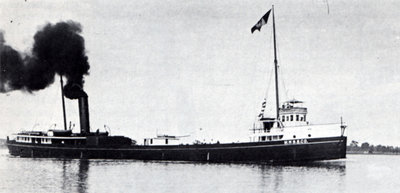
MANCHESTER is downbound in the St. Clair River in a photo by Pesha.
Her new owners painted MANCHESTER's hull and spar deck rail black, with a narrow white stripe at deck level and 'M.W.S.S.CO.' in large white letters on the black rail at the base of the forecastle. The forecastle itself was white, as were the forward cabins and the doghouse. The after cabin was white, but the boilerhouse was a dark colour, probably black. The stack was all black. At about the same time as the sale of the steamer to the Milwaukee-Western Steamship Company in 1898, a new steel deck was installed.
Shortly after the turn of the century, MANCHESTER received a reconstruction which served to modernize her appearance rather considerably. A section of the side planking at the after end of the forecastle was opened up, so as to admit much-needed light and fresh air to the cabin inside, and a corresponding section of the closed rail on the forecastle head was removed and replaced by an open rail. A sunshade was placed over the centre window in the pilothouse. As well, a large, steel, raised coal-bunker hatch was placed forward of the boilerhouse in order to avoid having to load bunkers through the spar deck, and to increase the amount of bunker coal that the ship could carry.
However, the most noticeable change in the appearance of the steamer was created by the removal of the original three masts, which was done because it no longer was considered necessary for steamers to carry auxiliary sail, and because the old masts were getting in the way of the more modern loading and unloading machinery that was provided at many lake docks. A new, tall and raked pole foremast was stepped through the texas cabin, while a matching mainmast was positioned abaft the funnel.
It is interesting to note that, from this time through to the end of her ownership by the Milwaukee-Western Steamship Company, MANCHESTER's name was carried on the narrow strip of woodwork that had been left over the open section of the after portion of the forecastle. This was a most unusual location for a steamer's name and, offhand, we cannot think of any other lake vessel that ever carried her name in a similar position.
In 1915, D. Sullivan & Company, Chicago, took over the operation of MANCHESTER for the Milwaukee-Western Steamship Company. Captain Denis Sullivan obviously considered that MANCHESTER required some updating, for he did considerable work on her at that time. The old texas remained, but the original pilothouse was removed. In its place was constructed a new two-decked structure with a rounded front and many large windows on both levels. It provided increased navigation space, better visibility, and protection for the ship's officers from the elements. This combination of a new "upper and lower" pilothouse would remain with the steamer for the rest of her long career and would be a sort of "trademark" for her as the years passed.
At the same time, the doghouse was removed from the spar deck, no doubt because more commodious facilities were provided elsewhere for the crew, and also because deckhouses took up deck space that could better be used otherwise and also got in the way of cargo-handling gear. During the course of this reconstruction, the ship's tall foremast was cut a bit shorter, while the mainmast was decimated, being lopped off just above the top of the funnel. A short pipe addition was then attached to the top of the truncated mainmast. The other changes made to MANCHESTER at this time seem to have been appropriate, but we cannot imagine any good reason for the chopping down of the mainmast, which definitely proved to be detrimental to the appearance of the steamer.
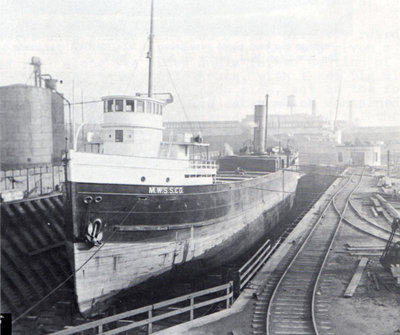
Buffalo Dry Dock Co. photo caught MANCHESTER on the dock on November 10, 1919. The package freighter in the background is NORTH STAR.
It has also been said that some improvement of the steel deck may have been done at this time. It will be recalled that a new steel deck was fitted in 1898, and it has been suggested that deck work also was done in 1908, although we cannot find any confirmation of this latter report.
In 1920, it was decided that MANCHESTER's two original boilers had reached the end of their usefulness, and accordingly the steamer was taken to the yard of the Manitowoc Shipbuilding Corporation at Manitowoc, Wisconsin. There, two new single-ended, coal-fired Scotch boilers were added, each of them measuring 12'9" by 11'6". The addition of these new boilers in place of the originals undoubtedly prolonged the life of the vessel by many years.
In 1921, the steamer was renamed (b) JOS. W. SIMPSON and, over the winter of 1921-22, she was shortened by about thirty feet by the Manitowoc Shipbuilding Corporation in order to make her suitable for service through the locks of the old Welland and St. Lawrence canals, into which she earlier had been too large to fit. As shortened, the steamer measured 250.8 feet in length, 42.0 feet in the beam, and 20.7 feet in depth, with her tonnage reduced to 1813 Gross and 1315 Net.
Then, in 1923, JOS. W. SIMPSON was sold to the Reiss Steamship Company of Sheboygan, Wisconsin, which undoubtedly continued to use her in the coal trade. She did not remain in the Reiss fleet for long, however, for in 1924 she was purchased by the George Hall Corporation of Ogdensburg, New York, no doubt for the coal trade on the lower lakes and the St. Lawrence River. A photo dated 1925 shows JOS. W. SIMPSON with a black hull, white cabins, and an all-black stack, and we have no evidence to suggest that this particular ship ever was given the white "wishbone" and 'H' stack design which most other Hall vessels (of both U.S. and Canadian registry) were carrying at that time.
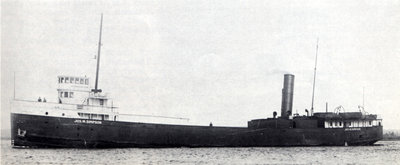
JOS. W. SIMPSON was sailing for the George Hall Corporation when A. E. Young took this photo at Little Rapids Cut in 1925.
About 1926, Hall sold JOS. W. SIMPSON to the Madden Coal Corporation of Ogdensburg for continued use in the coal trade. The 1927 U.S.M.V. indicates that her port of registry had been changed from Milwaukee to Ogdensburg and shows her registered owner as George J. Madden, although the 1928 edition of the register shows the Madden Coal Corporation as official owner. During the 1928 season, JOS. W. SIMPSON was fitted with a deck crane so that she could handle her own cargoes at docks which were not equipped with such machinery. The crane was fitted onto the steamer by the Buffalo Dry Dock Company at Buffalo, New York.
During her years in the Madden Coal Corporation fleet, the SIMPSON's hull and deck rail were painted black, while her forecastle and cabins were white. The boilerhouse and bunker hatch were also painted black. The stack was all black at first, but in the later years of service for Madden, a large white letter 'M' was added to the funnel.
During the season of 1936, JOS. W. SIMPSON was sold to the J. W. Simpson Transportation Company of Escanaba, Michigan, a firm concerning which we do not have any information whatever. It has been suggested that, during this period of her career, she may have been chartered to the Sawyer Stoll Lumber Company, but again we have no confirmation of any such arrangement.
In 1938, JOS. W. SIMPSON was sold to Edwin F. Priddle and the Edwin F. Priddle Lumber Company Ltd., of Gore Bay, Ontario. Transferred to Canadian registry (C.170256) and enrolled at Toronto as (c) MINDEMOYA, she was placed under the management of the Mindemoya Transportation Company Ltd., Toronto. When she was brought into Canadian registry, MINDEMOYA's dimensions were measured as 243.2 x 41.8 x 19.6, 1778 Gross and 1084 Net. The name MINDEMOYA was a reference to the small Ontario home town of Edwin Priddle.
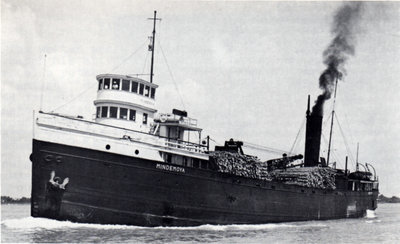
Perhaps the best photo ever taken of MINDEMOYA was made by the late Capt. W. J. Taylor on July 31, 1940.
During the term of Priddle's ownership, MINDEMOYA carried many cargoes of timber (including hardwood), as well as coal and silica. There appears to have been a close connection at this time between the Priddle interests and the Hindman - Evans lumbering business on Manitoulin Island. At this time, MINDEMOYA carried the same colours as in previous years, except that her stack once again was all black. Both her fore and main masts had been taken out and replaced with short pipe masts, but when she went into the lumber trade for Priddle, she was given a short and heavy kingpost-type spar, which was set between the bunker hatch and the boilerhouse, and which was fitted with a short boom to assist in handling cargo.
In the autumn of 1941, MINDEMOYA was drydocked at Manitowoc for an extensive refit in anticipation of possible service on salt water during World War Two, as unusual as it might have been to send a vessel of her type into deep-sea service. She did not go to the coast immediately, however, and it was not until the autumn of 1942 that her ownership was transferred to the Peruvian Steamship Company Ltd. At that time, MINDEMOYA was taken down the canals and, in due course of time, she set out from Montreal, bound for the Rio de la Plata of South America, where it was intended to use her as a bunkering vessel.
MINDEMOYA did not get far along her route to South America, however. As a result of the lateness of the season and the severe weather conditions that she encountered on the lower St. Lawrence River, she was able to proceed only as far as Anticosti Island. The steamer then was turned around and retraced her steps back into the lakes. She spent the winter of 1942-43 laid up on the west wall of the turning basin at Toronto, and during the spring she was painted up and generally made ready to go into service again. Photos taken of her whilst fitting out in 1943 show that, by that time, she had lost her pipe mainmast, and the cargo-post in front of the boilerhouse had become the true mainmast. It still had its cargo boom, but that boom would disappear before many more seasons had passed.
MINDEMOYA was back in service in 1943 under the ownership of the Albatross Steamship Company Ltd., Montreal, which retained her old black and white colours. The steamer was under "British foreign registry" during this period, and Edwin F. Priddle still retained an interest in the operation. The master of MINDEMOYA in 1943 was Captain Filicano ("Frank") Manzzutti, who had been born in Italy in 1910, and who had moved with his family to Sault Ste. Marie, Ontario, in 1912. He began sailing the lakes in 1928, had his captain's ticket by 1936, and was in the C.S.L. fleet before moving over to take command of MINDEMOYA.
With the coming of the 1944 season, Capt. Manzzutti assumed ownership of MINDEMOYA, the operating company being the Mindemoya Steamship Company. Once more, however, a change in ownership made no alteration to the livery of MINDEMOYA, and she looked just as she had in previous years.
In 1946, Capt. Manzzutti transferred the ownership of his steamer to the Yankcanuck Transportation Company Ltd., Toronto, and the ship was renamed (d) YANKCANUCK (I). This peculiar name was chosen as a reference to Frank Manzzutti himself, a naturalized Canadian, and to his wife, the former Eleanor Cox, who was an American born in Wisconsin. In fact, the two had been married in a ceremony held on board MINDEMOYA at Midland, Ontario, on December 9th, 1944.
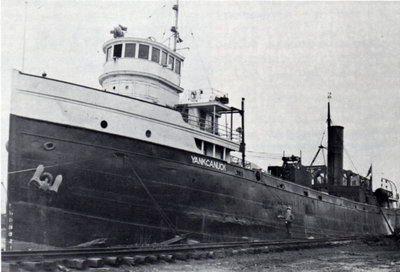
J. H. Bascom photo shows YANKCANUCK at the Century Coal Dock, Toronto, on May 21, 1956. That's Ye Ed. standing beside the steamer!
In 1950. the ownership of YANKCANUCK was transferred to Yankcanuck Steamships Ltd., Sault Ste. Marie, Ontario, and in 1951, the company added two more vessels to its fleet, these being the "Wolvin" canallers MANZZUTTI and MANCOX. These 1903-built steamers, which the company converted to craneships, had a colourful new stack design, but the same never was applied to the funnel of YANKCANUCK, perhaps out of deference to her status as a lake veteran and the very old-style appearance which she still wore so proudly. Her stack remained all black for the rest of her life, and about the only noticeable updating of any nature that was done was the replacement of the old wooden-post open rail on her forecastle head with steel pipe rail. (Of course, the closed wooden rail forward of the open section remained.)
Looking more and more of an anachronism as each year passed, but carrying her years with grace, YANKCANUCK plodded on into the mid-1950s, handling any cargo that could be obtained for her. She visited a variety of interesting ports, such as (in no particular order) Penetanguishene, Michipicoten Harbour, Green Bay, Muskegon, Burnt Island, Little Current, South Bay, Meldrum Bay, Gore Bay, Pigeon River, Filer City, Manistee, Marathon, West Bay, Christian Island, MacGregor Bay, Cook's Dock, Wikwemikong, Gargantua, Manitowaning, Blind River, Providence Bay, Thessalon and Michael Bay, to name but a few of the places at which she called.
YANKCANUCK's last season of operation was 1957, and on May l7th of that year, she was aground in the mud off the piers at Whitby, Ontario, on a rare visit to that small Lake Ontario port. She was released and ran for the duration of that season. She did not, however, fit out in 1958, and she spent the whole of that year lying idle in the slip behind Doran's Brewery at the Canadian Soo.
During the early part of 1959. YANKCANUCK was partially stripped where she lay, her after cabin, stack, engine and boilers being removed. As well, her masts were cut away and the forecastle went as well. For some reason, the two-decked pilothouse structure, the texas cabin, and the house that had been contained within the forecastle were left intact, giving the cut-down hull a most peculiar, gaunt appearance. By late June of 1959. the hull had been towed to a slip adjacent to the plant of the Algoma Steel Corporation Ltd., where the scrapping of the hull continued slowly. By the early summer of 1960, YANKCANUCK had been cut down to the tank top, and what remained was burned in order to salvage the last of the metal.
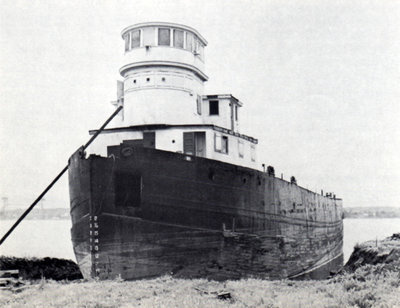
The stripped remains of YANKCANUCK lie along the upper St. Mary's in a June 21, 1959 photo by J. H. Bascom.
Thus ended the long career of one of the most interesting freighters ever to sail the lakes, and the last composite-hulled bulk carrier in service. She outlasted by about a quarter of a century the next most long-lived of the composite freighters, and it is interesting to note that her demise finally came at almost the same time as that of the little composite-hulled Toronto Island passenger ferry and freight boat T. J. CLARK.
The name YANKCANUCK did not die with the dismantling of the famous old steamer, however, for it was given to a new, steel-hulled, diesel-powered, craneship which was built for Yankcanuck Steamships Ltd. in 1963 at Collingwood. MANZZUTTI and MANCOX were retired in 1967, sold for scrapping in 1970, and were dismantled at Hamilton in 1971 at 68 years of age. YANKCANUCK (II) operated for Yankcanuck Steamships Ltd. until about 1972, when she was taken over by the Algoma Steel Corporation Ltd. She still carries on the famous name today.
Ed. Note: Your Editor and the T.M.H.S. Secretary, both of whom spent considerable time trying to piece together this feature, extend sincere appreciation for the assistance rendered by Capt. Frank Manzzutti and Capt. G. I. ("Buck") Longhurst in providing details of the latter years of the career of MINDEMOYA/YANKCANUCK. Without their help, we would not have been able to present in such detail the history of the steamer after she came under Canadian registry.
Previous Next
Return to Home Port or Toronto Marine Historical Society's Scanner
Reproduced for the Web with the permission of the Toronto Marine Historical Society.